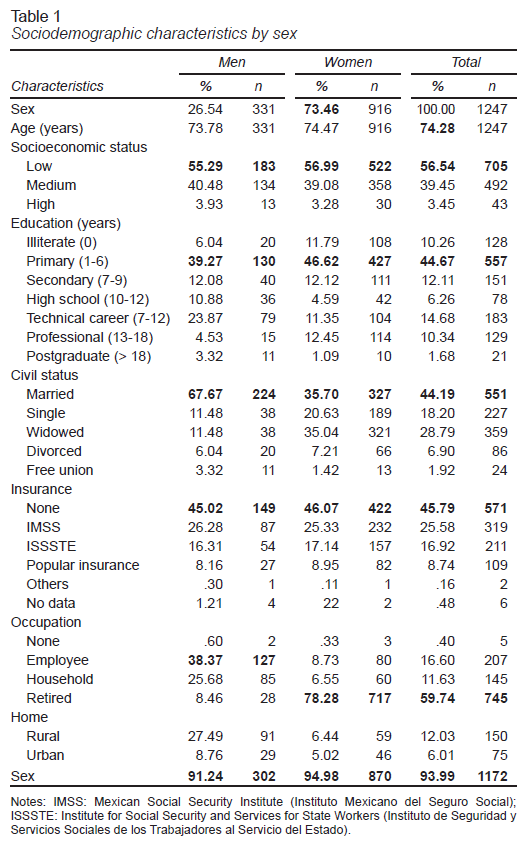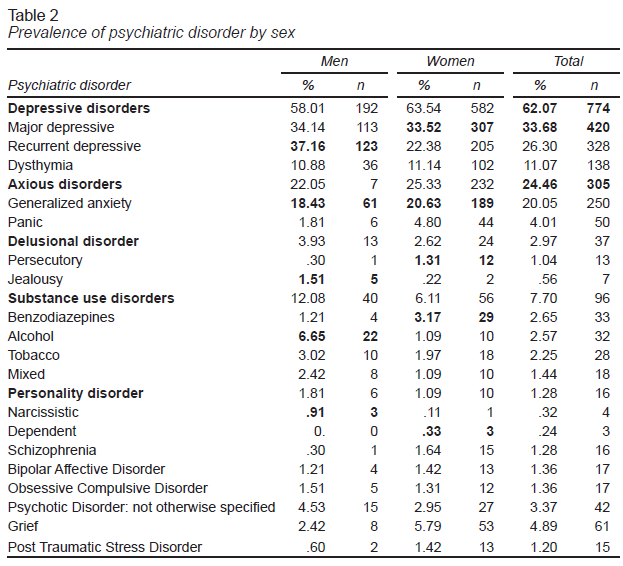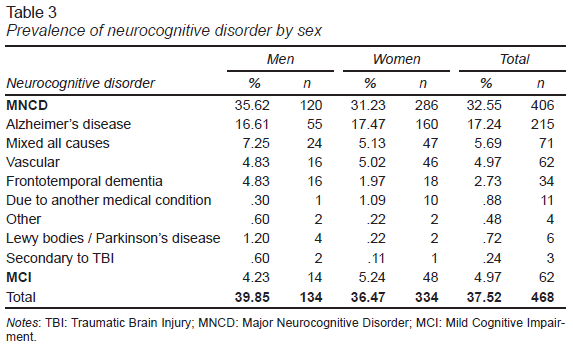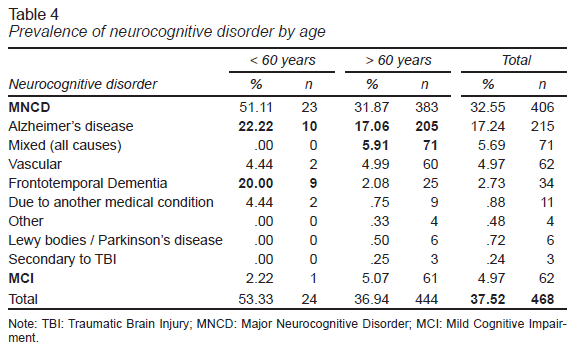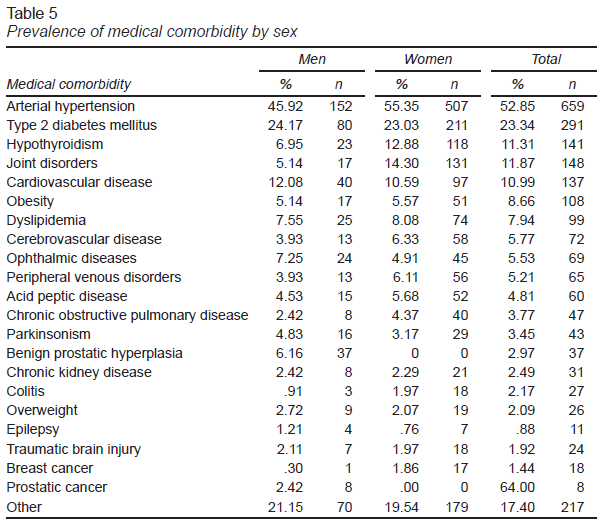INTRODUCTION
The demographic and epidemiological transition, longer life expectancy, the decrease in the fertility rate with the consequent aging of the current population has had implications for global health systems (Alvarado García & Salazar Maya, 2014). At the end of the 1970s, a twist of the population pyramid was predicted, which would culminate in 2050. The number of people over 60 years will increase from 600 million to almost 2 billion in low- and middle-income countries, where it will happen faster than in high income countries and the elderly population will increase by four times in the next 50 years (UN, 2002). In Latin America, adults over 60 years will increase from 8% in 2000 to 14.1% in 2025, and 22.6% in 2050. This rate will be higher in women (Guzmán, 2002).
In 2015, life expectancy in Mexico was 74.9 years and by 2050 it will be estimated at almost 80 years (González & Ham-Chande, 2007). However, in the last five years of life they will have more diseases, loss of functionality, detriment of the quality of life, and well-being (González, 2015). Aging is associated with a higher burden of disease, 35 out of 100 older adults have at least two comorbidities (López Arellano, 2015). According to the World Health Organization, cardiovascular diseases are the leading cause of death around the world (WHO, 2021). The Mexico’s National Survey of Health and Nutrition (ENSANUT) 2010 reported that 31.1% of Mexicans had arterial hypertension (AH) and for 2014 it was estimated that approximately 24 million adults over 20 years of age had AH (Velázquez-Monroy et al., 2003). The ENSANUT 2012 reported that 9.17% of adults have been diagnosed with diabetes mellitus; of these, 46.95% also reported a diagnosis of AH, 4.47% a history of heart attack, and 54.46% a family history of diabetes mellitus (Hernández-Ávila, Gutiérrez, & Reynoso-Noverón, 2013).
Mental illnesses affect a third part of the Mexican population according to the last National Survey of 2003, where 28.6% of the population had suffered a mental disorder at some point in their life (Medina-Mora et al., 2003). Mental and behavioral disorders went from seventh place in 1990 to fourth in 2016 in terms of frequency (Lozano et al., 2012). In Mexico, at least 14.3% of the general population suffered from an anxiety disorder in 2012, with Generalized Anxiety Disorder (GAD) being the most common, with a prevalence between 3% and 5.7% in primary care services (Comité - Academia Nacional de Medicina [ANMM], 2012). The prevalence of GAD in adults over 60 years is between 3.2% and 14.2%, where they are usually underdiagnosed and undertreated in clinical practice due to the change in their clinical presentation (Andreescu & Lee, 2020; WHO, 2017).
The prevalence of major neurocognitive disorder (MNCD) or dementia in Latin America was between 5% and 8% (Prince et al., 2013); 10.66% (Ribeiro, Teixeira-Santos, Caramelli, & Leist, 2022) and 11% (Zurique Sánchez et al., 2019), for those over 60 years old; grew exponentially with age, doubled every five years, and showed a predominance on females who came from urban area (Garre-Olmo, 2018). In Mexico, the prevalence of MNCD and mild cognitive impairment (MCI) were 7.3% and 7.9%, respectively. The highest values were observed in older women, with low literacy and living in rural areas (Arias-Merino, Mendoza-Ruvalcaba, Arias-Merino, Cueva-Contreras, & Vázquez Arias, 2012). Alzheimer’s Disease (AD) is the most common cause of MNCD. Most cases occur after the age of 60, in favor of Late-Onset AD, while occurring in those younger 60 years are rather rare, accounting for less than 5% of all cases, and are called Early-Onset AD (Long & Holtzman, 2019; Garre-Olmo, 2018).
Vascular dementias are the second most common cause of cognitive impairment in Latin America (Secretaría de Salud, 2017; Ribeiro et al., 2022). There are other possible MNCD aetiologies, such as mixed causes (Moreno-Cervantes et al., 2017), the frontotemporal dementia complex (Rodríguez-Leyva et al., 2018), Lewy body dementias (Espínola Nadurille, Dolores Velasco, Ramírez-Bermúdez, Sosa Ortiz, & Becerra Pino, 2007) and Parkinson’s disease dementia (Secretaría de Salud, 2010), among others.
Geriatric syndromes occur in older adults due to a higher burden of comorbidities, age-related physiological changes, and being more susceptible to iatrogenic complications (van Rijn et al., 2016). There are different syndromes such as frailty, immobility, urinary and fecal incontinence, confusional state, among others (Lee, Cigolle, & Blaum 2009). In a population-based study of the 10/66 study, incontinence, hearing impairment, immobility, and malnutrition were found to be in a linear fashion with the presence of MNCD and its severity (Prince et al., 2011).
Considering the last data, we carried out the first study of its kind in the Psychogeriatric Clinic (PC) of the Ramón de la Fuente Muñiz National Institute of Psychiatry (INPRFM) to evaluate the social, demographic characteristics, as well as determine which were the medical pathologies, psychiatric and geriatric syndromes. Being an exploratory study, a working hypothesis could not be made.
METHOD
Design of the study
Descriptive, observational, cross-sectional, retrospective study. A database was created with the information recorded in the patient’s digital clinical records who attended the INPRFM PC, located in Mexico City, Mexico; mental health center level III of psychiatric complexity. All patients who received care from January 1, 2011 to December 31, 2020 were included. No additional instruments or scales were applied to those already recorded.
Participants
All patients over 60 years of age (May60) and those under 60 years of age (Men60) who were part of a study for subjective memory complaint or an early-onset MNCD were included. People whose information was incomplete by more than 50%, May60 adults who had not consulted in the CP and Men60 who did not consult due to suspicion of an early-onset MNCD were excluded. The clinical and psychiatric diagnoses were found according to the International Classification of Diseases 10 revision (ICD-10®), as well as those recorded in the Diagnostic and Statistical Manual of Mental Disorders (DSM®) fourth edition revised version or the DSM-5®, so for their grouping their equivalences were sought, and all were expressed according to the ICD-10® and the comorbidities were grouped according to their epidemiological interest. Geriatric syndromes were tabulated as they were found in the file.
Measurements
Different variables were measured, such as sociodemographic variables, which are understood as social, economic, and demographic indicators that allow grouping subjects into homogeneous groups and thus being able to define them objectively; the clinical are those used in the exercise of medical practice through objective direct observation of the patient and her treatment. In the assessment of admission to the clinic, different screening scales were performed on the patients, such as: the Yesavage Geriatric Depression Scale-30 (GDS), which allows evaluating depressive symptoms in 30 items, with a higher positive cut-off point at 11 points (Baker & Espino, 1997), the Short Anxiety Screening Test (SAST), with a score between 0 and 40, which is positive with more than 24 points (Sinoff, Ore, Zlotogorsky, & Tamir, 1999); the Clock Test with a degree of error between I and V; which from grade II is altered (Cahn et al., 1996), the Lawton and Brody Scale (Gallo & Paveza, 2006) that evaluates functionality with instrumented activities of daily living with a score between 0 and 8. The Katz index that evaluates six functions of the basic activities of daily life, is scored with the letters from “A” to “G” (Katz, Downs, Cash, & Grotz, 1970). The Mini-Mental State Examination (MMSE) was also used, with a score between 0 and 30, with a cut-off point of less than 24 points (Beaman et al., 2004) and the Montreal Cognitive Assessment (MoCA) with a score of less than 26 points (Aguilar-Navarro et al., 2018).
Statistical analysis
Variables were recorded using the IBM® SPSS Statistics Program, version 20.0. The analysis was performed using descriptive statistics, where the qualitative variables were described in terms of percentages. Quantitative variables were calculated as means and standard deviations.
Ethical considerations
The World Medical Association declaration of Helsinki and the regulation of the general health law in the field of research for health of 2014 Mexico were followed. It was submitted for evaluation by the INPRFM Thesis Committee with approval on April 6, 2021, and by the INPRFM Research Ethics Committee with approval number CEI/C/021/2021 of June 28, 2021.
RESULTS
A total of 2056 records were found, of which 1247 met the inclusion criteria and 808 were excluded.
Sociodemographic characteristics
The mean age was 74.28 years, with a minimum age of 41 years and a maximum of 101 years (SD ± 8.53). The patients were mainly women 73.46% (n = 916), with primary education level 46.62% (n = 427), married 35.70% (n = 327), home-based 78.28% (n = 717), low socioeconomic level 56.99% (n = 522), urban area based 93.99% (n = 1172), and lack of social security 46.07 (n = 422; table 1). The number of patients who consulted per year between 2013 and 2019 was an average of 171. But during the year 2020, 44 consulted due to the SARS-CoV2 pandemic.
Characteristics of psychiatric disorders
Depressive disorders were the most frequent psychiatric disorders 62.07% (n = 774), followed by anxiety disorders 24.46% (n = 304). Within depressive disorders, the most frequent was major depressive disorder 33.68% (n = 420) and of anxiety disorders was GAD 20.05% (n = 250). The patients could have comorbidly two depressive disorders or a depressive disorder and an anxiety disorder, associated with other disorders such as substance use or a personality disorder, among others (Table 2).
Characteristics of dementias: MCI and MNCD
The prevalence of a neurocognitive disorder was 37.52% (n = 468), the main cause being MNCD with 32.55% (n = 406), caused by AD 17.08% (n = 213), followed by mixed dementias (for all causes) 5.69% (n = 71), and then vascular dementia 5.69% (n = 71). The prevalence of MCI was 4.97% (n = 62; Table 3).
When dividing the groups by age into younger (Men60) and older than 60 years (May60), 24 of 45 cases were found positive for a neurocognitive disorder in the Men60 group (53.33%) and 444 of 1202 cases in May60 (36.94%). The MNCD main cause for both groups were AD with 17.24% (n = 215), by groups in Men60 was 22.22% (n = 10) vs May60 was 17.06% (n = 205). The etiology of the second causes in both groups changed, for the Men60 it was fronto-temporal dementia 20.00% (n = 9), while for the May60 it was mixed dementia (all causes) 5.91% (n = 71; Table 4).
Clinical metrics
Of the 774 patients with a depressive disorder, 49.74% (n = 385) had a GDS scale record with a mean score of 17.08 points (SD ± 8.94). Of the 305 patients with an anxiety disorder, 49.94% (n = 134) had a SAST record with a mean score of 24.25 (SD ± 10.63). Of the 675 patients with cognitive disorders under study, 58.52% (n = 395) had the MMSE recorded with a mean score of 18.88 (SD ± 11.79) and MoCA was found in 17.94% (n = 31) with an average score of 17.94 (SD ± 5.70). In addition, the record of the Clock Test was found in 38.52% (n = 480), with a median of III error degree points. The Lawton and Brody Scale was reported in 4.89% of the patients (n = 33) with a mean of 4.52 (SD ± 2.40) and the Katz index, reported in 32.00% (n = 399) with a mode of A by 15.2%.
Characteristics of medical comorbidities
The overall prevalence of AH was 52.85% (n = 659) and type 2 diabetes mellitus was 23.34% (n = 291), being more prevalent in women. Joint disorders were present in 11.87% and hypothyroidism in 11.31% of the cases (Table 5).
Characteristics of geriatric syndromes
The cumulative prevalence of at least one geriatric syndrome within the analyzed population was 64.42% (n = 764 records). A person could have up to six diagnosed syndromes. The most prevalent was visual deafferentation 15.64% (n = 195), followed by auditory deafferentation 11.15% (n = 139) and polypharmacy 6.78% (n = 84). In addition, a record was found for falls, frailty, acute confusional state, incontinence, gait disorder, edentulism, caregiver stress syndrome, malnutrition, constipation, functional depression, immobility, and pressure ulcers (unpublished data).
DISCUSSION AND CONCLUSION
The main psychiatric etiology was depressive disorders, with an overall prevalence of 62.07% and specifically, major depressive disorder with a prevalence of 33.68%. The prevalence of depression in old age varies according to the population and the economic development of the countries. In Mexico, it varies between 26% and 66%. In Puerto Rico, 2.3% and in the Dominican Republic 13.8%. In Peru it was reported between 9.8% and 15.97%. The prevalence of depression in Chile has been reported between 7.6% and 16.3%. In Colombia, the national health survey reported the prevalence between 49 to 60% (Calderón, 2018) and the data from the SABE 2018 Survey between 1% and 12.3%. (Cano Gutiérrez et al., 2018). An increase in prevalence has been reported in subjects beyond 75 years (Luppa et al., 2012).
Depression in older adults should be considered as a general health problem, the severity of which is associated with increased comorbidity, functional decline, excessive use of health care resources, and increased mortality (including suicide; Taylor, 2014). It occurs mainly at the primary care, where it is underdiagnosed and inadequately treated (Licht-Strunk et al., 2009). It predisposes to medical diseases and promotes biological aging. Medical illnesses also increase the risk. It is associated with medical and psychosocial problems with difficulties at the individual and community level. They have a lower response to antidepressants than younger adults (Alexopoulos, 2019); it increases the risk of frailty (Borges et al., 2021) and dementia (Livingston et al., 2020).
Differentiating between depression, MCI, and MNCD in early stages can be challenging due to technical limitations and lack of consensus regarding clinical monitoring strategies (Chakrabarty, Hadjipavlou, & Lam, 2016). Approximately 30-40% of older adults without an MNCD and with comorbid depression show signs of executive dysfunction on cognitive tests, with impaired tests of verbal fluency, cognitive inhibition, semantic planning and organization, episodic memory, and visuospatial skills, as well as memory and word list recall. Whereas memory in recognition and cued recall conditions and narrative contextual memory are often intact (Morimoto, Kanellopoulos, Manning, & Alexopoulos, 2015). The prevalence of depression in patients with MCI in community samples can be 25% and in clinical samples 40% (Ismail et al., 2017). In general, depression should be treated and then reassessed if there is a MNCD. However, cognitive dysfunction is prevalent in depression and often persists during the full episode remission (Chakrabarty et al., 2016). The mainstay of treatment is the combination of psychotherapeutic and pharmacological treatments, including electroconvulsive therapy for severe or treatment-resistant cases (Casey, 2017; Canadian Coalition for Senior’s Mental Health [CCSMH], 2021).
Anxiety disorders may be comorbid with depressive disorders, with a negative impact on complete remission. The course of anxiety severity appears to depend on the interaction of personality traits and life events (van der Veen et al., 2021).
A greater increase in the prevalence of dementias is expected in Latin America than in high-income countries, between 7.1% and 11.5% for those over 60 years of age; compared with a lower, stable, or reduced prevalence in the United States and Europe. Different non-modifiable and modifiable factors have been identified, such as a marked genetic heterogeneity, with specific populations identified in Colombia, with the identification of the “paisa gene” (Vasquez et al., 2021), in Mexico with the identification of the “Jalisco gene” (Dumois-Petersen et al., 2020); Dominican Republic, Puerto Rico, and in Cuba (Llibre-Guerra et al., 2021). The cost of AD is a greater burdensome in Latin America than it is for the rest of the planet (Custodio, Wheelock, Thumala, & Slachevsky, 2017) due to a more challenging intervention of risk factors, social determinants of health, and the effect of the SARS-CoV2 pandemic (Parra et al., 2021).
The global prevalence of MNCD in Latin America is 11% (Zurique Sánchez et al., 2019). In Mexico, the Health, Wellness and Aging Study (SABE) found a prevalence of Cognitive Impairment of 8.00% at the national level. The National Study on Health and Aging in Mexico (ENASEM) found a prevalence of dementias of 6.10%. Data from the 10/66 Dementia Research Group found a prevalence of MNCD of 8.60%. The National Survey of Health and Nutrition (ENSANUT) had a prevalence of dementia of 7.90% (Sosa Ortiz, Astudillo García, & Acosta Castillo, 2017). When analyzing the panorama in other countries such as Colombia, a study carried out at a Bogotá’s Cognition and Memory Clinic found the most frequent psychiatric diagnosis was AD (43.45%) followed by frontotemporal dementias (8.62%) and affective disorders (8.29%). Dividing the group by diagnoses and age, the global prevalence of AD was 56.3%, being the main cause in patients older than 65 years with 33%, results like those found in this study. But, in those under 65 years of age, the main cause was frontotemporal dementia with 40% (Moreno Moreno, Matallana Eslava, & Cano Gutierrez, 2015). In San José, Costa Rica, a prevalence of MNCD of 65.8% was found, with AD being the most frequent etiology with 45.6%, followed by vascular dementia with 30.3% (Miranda-Valverde et al., 2015). The long-term effects of the SARS-CoV2 pandemic and a possible increase in the prevalence of dementia in Latin America, where an increase of up to 15.6% is estimated (Soto-Añari et al., 2021), must be considered.
Also, emerging risk factors should be considered, such as air quality and pollution in Mexican cities where a high presence of particulate matter PM2.5 and ozone O3 has been found, which are associated with a higher risk of AD (Brito-Aguilar, 2019; Calderón-Garcidueñas et al., 2019).
The INPRFM has diagnostic studies of computerized tomography and magnetic resonance imaging; but it does not have functional neuroimaging studies such as positron emission tomography scan, studies of central or peripheral biomarkers for dementia, nor are genetic tests processed; to consider as limiting factors for diagnoses. A digital underreporting of the initial assessment scales, geriatric syndromes and medical comorbidities was found.
The results of this study are not expected to be generalized to the Mexican population; however, the results allow us to establish an approximate value of the population reality. Larger and more naturalistic studies should be carried out.
It is necessary to promote education about MNCD in the general population and in primary care physicians to improve early detection of the disease, promote effective referrals to specialized medical centers for difficult cases, strengthen clinical practices in rural areas, invest in further research to estimate the real population indicators of each region and support the development of effective public policies to improve the prevention, diagnosis, and clinical management of dementias (Xiang et al., 2021).
These are the first results found in the National Institutes of Mexico network. Information and researcher bias was found as a limitation. It is recommended to strengthen the outpatient follow-up system for patients to complete the diagnostic process and be able to offer continuity in outpatient care.
Aging in Mexico is more prevalent for women than men. The women who went to the PC have a primary education level, were married, live in urban areas, are home-based and do not have social security. The most common psychiatric pathology was depressive disorders followed by MNCD due to AD. Strategies should be created to promote the digital registration of information in the PC. From the database it will be possible to select the patients, develop new studies to find possible associations between the different variables, as well as differentiate the prevalence of depression in the elderly with and without MNCD. In addition, prospective studies should be carried out to evaluate the incidence and evolution of cognitive and psychogeriatric disorders of interest in PC, to make the public health problem visible to government entities.
